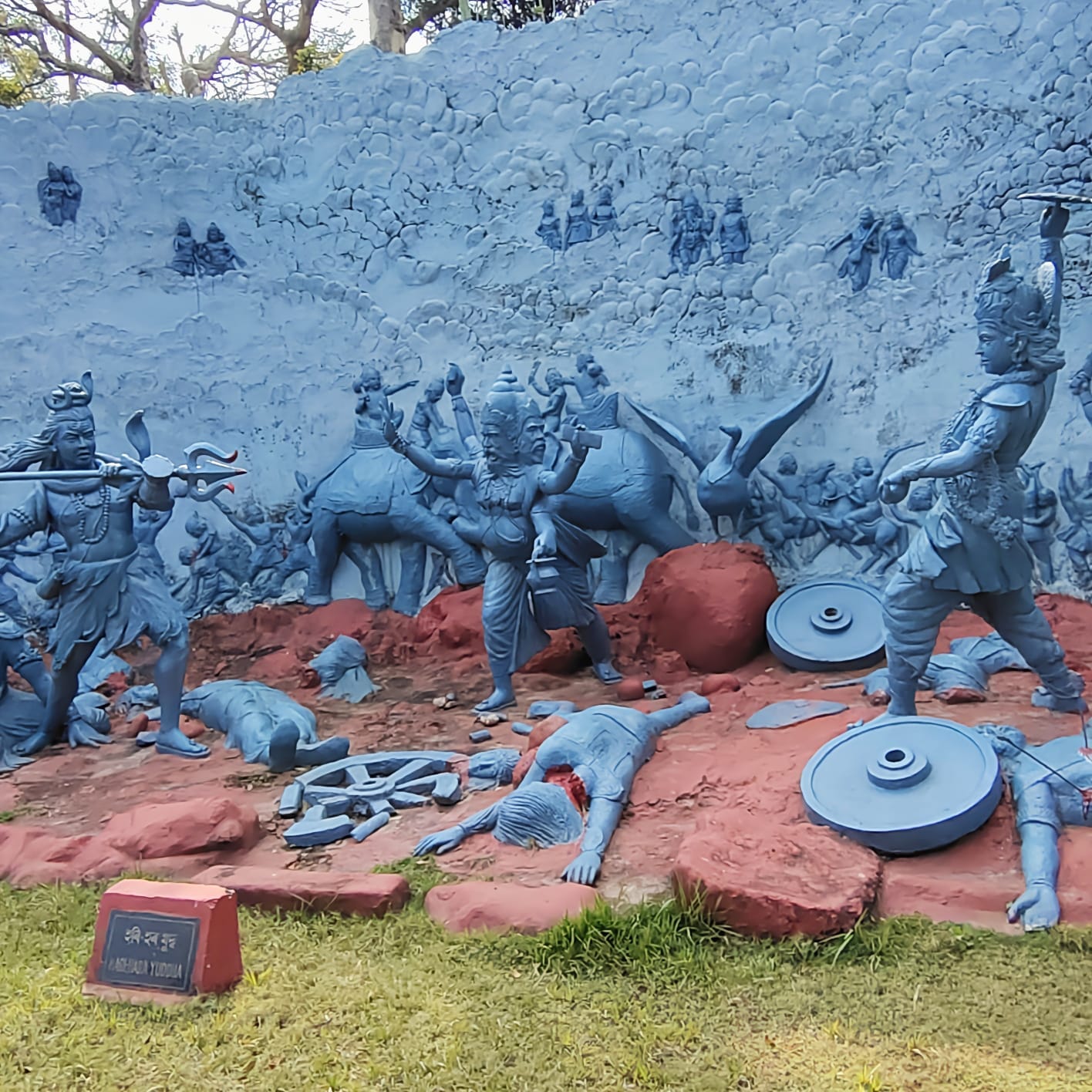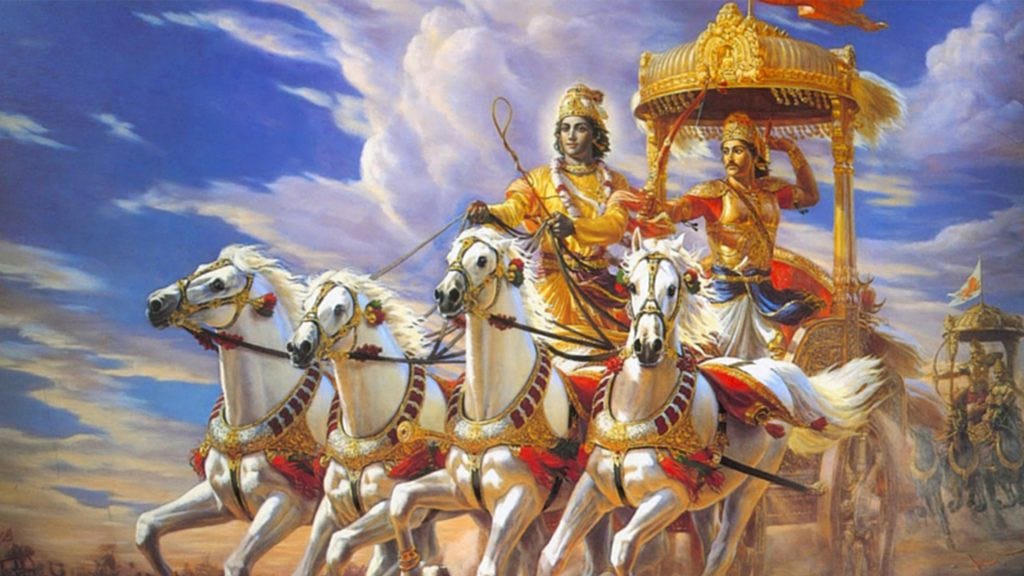The Harihara War: Lord Vishnu vs. Lord Shiva
The Complexity and Nuances of Upholding Dharma: Insights from the Harihara War.
The Harihara War— an introduction
In Hindu tradition, Lord Krishna and Lord Shiva stand as colossal figures, each commanding immense devotion. Yet, not many know of the Harihara War, where these revered deities were pitted against each other in battle. This article is our humble attempt to illuminate this fascinating episode.
The Dynamic Balance of the Trinity in Hinduism
In Hinduism, the concept of the divine trinity, or Trimurti, comprises Brahma, Vishnu, and Mahesh (Shiva), each with distinct yet interconnected roles that sustain the cosmic balance of the universe. Brahma is the creator, Vishnu the preserver, and Shiva the destroyer or transformer. While each deity operates within his own realm of influence, their roles are not isolated but rather overlap and intersect in complex ways.
Among Vishnu's many avatars, Lord Krishna stands out as particularly significant. As a pivotal character in the epic Mahabharata, Lord Krishna is credited with delivering the Bhagavad Gita, a timeless discourse on duty, righteousness, and the paths to spiritual liberation. The teachings contained within this sacred text serve as a spiritual and ethical compass for humanity.

The Concept of ‘Harihara’ and ‘Ardhanarishvara’
As Hinduism is a religion that acknowledges both the diversity and unity of the divine, it's not surprising that concepts like Harihara exist to embody these ideas. Harihara is a theological synthesis of Vishnu (Hari) and Shiva (Hara), two major deities who normally function in separate yet complementary domains. This concept serves as an instructive tool that encourages devotees to transcend sectarian divisions and to recognise the ultimate unity that underlies the apparent diversity of the world.
In a similar vein, the concept of Ardhanarishvara, which fuses the masculine and feminine aspects of divinity into a single entity, also speaks to the inherent unity within Hindu theology.
The Divine Conflict: The Harihara War—Upholding of Dharma
In the annals of ancient Indian history, the invasion of Lanka by Lord Rama, the sweeping narrative of the Mahabharata, and the transformative Kalinga War occupy places of singular distinction. These events are not just chronicles of martial prowess or territorial acquisition; they are grand cosmic dramas featuring celestial figures wielding divine armaments, all in the service of a higher purpose: the preservation and reaffirmation of Dharma, the universal moral and cosmic order. Amid these epic confrontations stands the lesser-known but equally riveting Harihara War, a unique face-off between two of Hinduism's most revered deities—Lord Krishna, known as Hari, and Lord Shiva, referred to as Hara. Importantly, in this specific context, Hari and Hara operate as distinct entities, and should not be conflated with the unified form of Harihara discussed in preceding paragraphs.
The Tale of Banasura: An Ardent Devotee with a Dangerous Ego
Once upon a time, Banasura, a mighty asura king, ruled over a vast kingdom centred in what is now Tezpur, Assam. A devotee of Lord Shiva, Banasura had earned his deity's protection through his unwavering devotion. Unfortunately, the boon of invincibility led him down the path of arrogance and megalomania, eventually attacking Kailash, Lord Shiva's abode, and earning his ire.
The Romantic Tryst: Usha and Aniruddha
Banasura's daughter, Usha, dreamt of a charming prince with whom she was deeply in love. Chitralekha, her magical maid, identified the prince as Aniruddha, Lord Krishna's grandson, and even managed to transport him magically to Usha's side. The love between Aniruddha and Usha was mutual, yet this match angered Banasura. He imprisoned his daughter and Aniruddha, setting the stage for a divine confrontation.
A Clash of Divinities: Krishna and Shiva Enter the Fray
Alerted by Narada, Lord Krishna mobilised a formidable army towards Sonitpura. Sensing the inevitability of his defeat, Banasura called upon Lord Shiva for assistance. What unfolded was nothing short of a celestial spectacle—a high-stakes battle between Hari and Hara. Although Shiva's formidable Pasupatastra was countered by Krishna's Narayanastra, Lord Shiva escalated the conflict by manifesting his awe-inspiring three-headed form. In response, Krishna invoked his own divine essence and beseeched Shiva, emphasising that true Dharma could not prevail if Banasura remained unchallenged and undefeated.
The Resolution: A Lesson in Compassion and Humility
Moved by Lord Krishna's wisdom and the futility of their cosmic duel, Lord Shiva relented. Lord Krishna spared Banasura's life but humbled him by removing his thousand arms, reducing them to just four. The episode culminated in a harmonious resolution: Usha and Aniruddha were united in matrimony, and Banasura, now humble and repentant, rededicated his life to serving Lord Shiva.
The Aftermath: A Land Named Tezpur
In the verdant hills of Assam, home to some of the world's most aromatic and matchless tea estates, lies a city steeped in mythical history—Tezpur. The name itself, a stark contrast to its serene surroundings, is a chilling remembrance of an epic clash. Derived from the words 'Tez,' meaning blood, and 'Pura,' meaning city, the name Tezpur evokes the intensity of the legendary Harihara War. A battle so fierce, it not only pitted divine against divine but also left the landscape irrevocably marked, staining the very soil with celestial blood. Though today the region may be more associated with the tranquillity of its tea gardens, the name Tezpur serves as an everlasting testament to that unparalleled conflict between Lord Krishna and Lord Shiva, a war like no other in the annals of both history and mythology.
The Complexity of Upholding Dharma: Harihara War Insights
The Harihara War is a fascinating episode that serves as a poignant reminder of the multi-faceted nature of Dharma. It teaches us that the path to righteousness is not linear, nor solely about conquering external forces of evil. Lord Krishna and Lord Shiva, each in their divine wisdom, demonstrate that Dharma is about mastering internal challenges like pride, arrogance, and ego as well, and it can be upheld through understanding, humility, and righteous action.
This narrative gains additional complexity when viewed through the lens of Harihara—a concept that merges the identities of both deities into a unified whole. In the Harihara War, the roles of Lord Shiva and Lord Krishna are not just distinct but in direct opposition, thus adding another layer of complexity to the already intricate fabric of Hindu theology. This confrontation between the two deities underscores the inherent intricacy and multiplicity of the divine, reminding us that the road to Dharma is fraught with paradoxes and nuances, demanding a broad-minded approach for its true understanding and application.
The Timeless Wisdom of Conflict Resolution and Peaceful Coexistence
Drawing upon the lessons of ancient narratives like the Harihara War, we find enduring wisdom applicable in today's complex world. Hinduism teaches us that even in seemingly insurmountable conflicts, a path of resolution that respects the dignity of all participants can be found. Lord Krishna, often seen as the quintessential diplomat, provides a blueprint for resolving disputes through dialogue and mutual understanding, rather than resorting to destructive combat.
In a contemporary context, this wisdom underscores the futility of armed conflict as a colossal waste of human potential and precious resources. Instead of fuelling warfare, these resources could be channelled into alleviating poverty, combating disease, providing disaster relief, and addressing the urgent challenges of climate change. If we can shift our focus from military might to constructive dialogue, we stand a much better chance of building a more peaceful and sustainable world for future generations. Our scriptures have all the lessons before us—if only we choose to learn from them and apply them.
EPILOGUE
I would like to extend my sincere acknowledgements to Mr Ramesh Negi, our friend and 1984 batch IAS colleague, who retired from the AGMUT cadre, for introducing me to the compelling narrative of the "Harihara War." Hailing from Himachal Pradesh, Negi Ji has served extensively in the North-East and held the esteemed position of Chief Secretary of Arunachal Pradesh.
Upon reading this article, he graciously sent me his insightful comments, which I include here with his explicit permission:
“Harihar Yudh has deep links to Raja Virbhadra and our Negi tribe in Himachal Pradesh. We have the Usha Devi temple at Nichar, and legend has it that some troops of Krishna didn't return to Dwarka on their way back from the Harihar Yudh; instead, they settled in the Himalayas. We, the Negis, are believed to be their descendants. Raja Virbhadra Singh, the late former CM of HP, hails from the same lineage.
When I was in Arunachal Pradesh, I discovered that the Banasur clan, known locally as Hosur, which means 'Asura,' are settled in the Seppa district; only 5,000 remain. Hidimba, who was originally from the Dimasa tribe in Assam, accompanied Bhim and is worshipped in Kullu. It's fascinating to see these pan-Himalayan connections."
==================
REQUEST: If you enjoyed this article from 'The KBS Chronicle', we encourage you to share it with others who might also find it valuable.
Thank you for your support.










EPILOGUE
I would like to extend my sincere acknowledgements to Mr Ramesh Negi, our friend and 1984 batch IAS colleague, who retired from the AGMUT cadre, for introducing me to the compelling narrative of the "Harihara War." Hailing from Himachal Pradesh, Negi Ji has served extensively in the North-East and held the esteemed position of Chief Secretary of Arunachal Pradesh.
Upon reading this article, he graciously sent me his insightful comments, which I include here with his explicit permission:
“Harihar Yudh has deep links to Raja Virbhadra and our Negi tribe in Himachal Pradesh. We have the Usha Devi temple at Nichar, and legend has it that some troops of Krishna didn't return to Dwarka on their way back from the Harihar Yudh; instead, they settled in the Himalayas. We, the Negis, are believed to be their descendants. Raja Virbhadra Singh, the late former CM of HP, hails from the same lineage.
When I was in Arunachal Pradesh, I discovered that the Banasur clan, known locally as Hosur, which means 'Asura,' are settled in the Seppa district; only 5,000 remain. Hidimba, who was originally from the Dimasa tribe in Assam, accompanied Bhim and is worshipped in Kullu. It's fascinating to see these pan-Himalayan connections."
Waking up to this beautiful narration is heavenly.
Dharma is about mastering internal challenges like pride, arrogance, and ego as well, and it can be upheld through understanding, humility, and righteous action.
These words have summed up the sermons of a thousand sages and a thousand books.
Thank you.
Ps. Your friend Mr. Negi ‘’s comments were “sone pe sohaga”